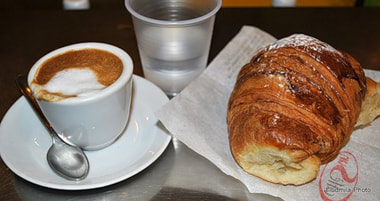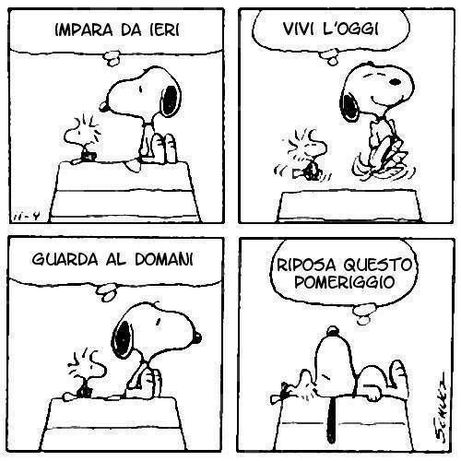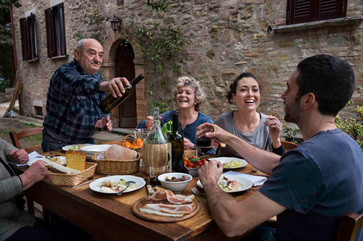
A typical Italian breakfast
The concept of riposo in Italy (and other Mediterranean countries) is often attributed to the scorching midday heat, especially in summer, complemented by hearty lunches typical of the Mediterranean diet. After a substantial meal, people naturally feel sleepy. Italians normally embrace this natural inclination to nap, aligning their daily routines with their biological rhythms, unlike Americans, who often ignore these signals.
One of the most surprising—yet often frustrating—things travelers discover in Italy is the long midday break, akin to the siesta in Spain. In northern Italy, this is known as riposo or la pausa, while in the south it is referred to as pennichella or pisolino. Riposo means to rest, while pausa signifies a break. Travelers, particularly Americans, may find it inconvenient that most shops and businesses close during this time for il pranzo (lunch), which is generally the largest meal of the day. Some businesses, including restaurants, retail shops, grocery stores, banks, pharmacies, and even post offices, can shut down around noon or 1 p.m. and may not reopen until 3-3:30 p.m. or later. During riposo, small towns often resemble ghost towns.

Snoopy Gets It: Learn from Yesterday, Live for Today, Look to Tomorrow, Rest this Afternoon
Surprisingly, even places you might expect to stay open, such as car rental offices, close for riposo. These offices often function as local brokers for larger companies and typically operate with only 2-3 staff members, all of whom take a break during riposo. In smaller towns, you might even find local police stations closed during this time. In my experience living in France, I found lunchtime closures were brief, usually lasting only 1.5 to 2 hours. However, in many small towns across Italy, riposo can extend until 4 or 5 p.m., with some restaurants not reopening until 6-8 p.m.

Pranzo con la famiglia
In terms of health, many experts suggest, “Eat breakfast like a king, lunch like a prince, and dinner like a pauper.” However, Italians tend to do the opposite. Their typical breakfast often consists of a sweet pastry and cappuccino (only in the morning), followed by the largest meal during riposo.
Though they could enjoy a more substantial breakfast with protein (ham, eggs) and fats (butter, olive oil), Italians generally prefer lighter meals. When they do have salads, they typically dress them only with oil and vinegar, avoiding additional protein sources like chicken or cheese.
Due to their hearty lunches, it’s common for Italians to take a nap during riposo. Traditionally, pranzo is considered the main meal of the day, starting with antipasti (appetizers), followed by a primo (first dish, usually pasta or risotto), and a secondo (second dish, typically a meat). These are often accompanied by one or more contorni (side dishes), such as salads or cooked vegetables like spinach sautéed in olive oil. The meal is often complemented by a bottle of wine.
Lunch is a cherished family time, especially in small towns throughout Italy. Children in middle and high school finish their classes before riposo, allowing them to join their families for lunch or be fed by their grandmothers. Younger children typically enjoy healthy lunches provided by their schools, staying a bit later.
Young men—unless they work in a big city—often live with their mothers until they marry. Mothers typically handle the cooking, but many young men take pride in their culinary skills. These family ties create a nurturing, relaxed, and family-centered culture.
When it comes to dinner, don’t expect to find a restaurant ready to serve before 7 or 8 p.m.
The later you travel into southern Italy, the later people tend to eat dinner. Before moving to France, I used to have dinner around 5:30 p.m., but after my time in Europe, my family now dines around 7:30 p.m., which is still an hour and a half later than most Americans are accustomed to.
Italians also enjoy an aperitivo around 5-6 p.m., particularly in Northern Italy, where it’s usually accompanied by small bites of food. Occasionally, they might skip dinner altogether or have a light meal after 8 p.m. Restaurants in Italy often open later than what Americans are used to, especially in southern towns where it’s uncommon to find places serving dinner before 8 p.m.
For Italians, time is less rigid compared to the American standard. The listed hours for business operations are more of a guideline than a strict schedule. If a shop advertises hours from 8 a.m. to 7 p.m., it might not open until 9:30 a.m.
Here are some common Italian terms you may encounter concerning operational hours:
giorni feriali Weekdays (literally, working days)
settimanale Weekly
quotidiano Daily
ogni ora Hourly
If you see an icon resembling a crossed hammer and sickle, it indicates “workdays,” meaning Monday through Saturday. Conversely, if you spot giorni festivi or a small cross, this indicates Sundays and religious holidays (there are many, as Italy is predominantly a Catholic country). Chiuso per ferie means closed for holidays, which typically extend to a full four weeks in August for most Italian workers. During this period, shops close, and families head to beach resorts or camping spots. If you see chiuso per lutto, it indicates the business is closed for mourning. Many shops remain closed on Sundays, regardless of whether they attend church or prefer to watch soccer matches.
A Commentary and Suggestions
Understanding this remarkable culture requires appreciating how Italians perceive time—not as a commodity to manage, but as a flowing river. The midday heat can be intense, and historically, when agriculture dominated many lives, it was respectful of nature and internal rhythms to rest during the hottest parts of the day. However, modern Italy has air conditioning that is effective and widely used. Italy’s rich beauty and history should encourage the growth of tourism, a vital part of its economy.
While embracing traditions is important, there may be some losses in job profits in areas where tourism is a key economic player during riposo. A balance can be struck where Italian culture thrives alongside growth. The World Travel & Tourism Council states that tourism contributes over $203 billion a year to Italy’s economy, surpassing the profits of fields like communication services, automotive manufacturing, and mining.
My advice to Italians is to keep shops and restaurants open during the day, particularly in areas relying heavily on tourism. Encourage employees to stagger their lunch breaks, thereby serving the tourists who generate considerable wealth for the country without compromising comfort or service.
On a related note, attention to public restroom facilities and trains should reflect the quality found in Italian homes. Ensure these facilities are properly maintained and well-stocked with toilet paper and toilet seats, as some public toilets poorly represent Italy’s standards. The squat-down, often referred to as a “Turkish toilet,” can be especially challenging for individuals with mobility issues or the elderly – a change is needed.
Lastly, visitors wish to experience authentic Italian cuisine, not fast food. Support local restaurants, particularly the Slow Food movement, by encouraging them to stay open during meal times tourists expect. This isn’t about transforming the Italian way of life but rather adapting to meet tourist expectations.
My thoughts are shared with tutto dovuto rispetto, aimed at promoting Italy’s beautiful culture alongside its remarkable tourism potential.
–Jerry Finzi
You can also follow Grand Voyage Italy on:
Twitter
Pinterest
Facebook



